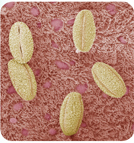35.2 Defenses Against Infection
 What are the body's nonspecific defenses against pathogens?
What are the body's nonspecific defenses against pathogens? What is the function of the immune system's specific defenses?
What is the function of the immune system's specific defenses? What are the body's specific defenses against pathogens?
What are the body's specific defenses against pathogens?
inflammatory response • histamine • interferon • fever • immune response • antigen • antibody • humoral immunity • cell-mediated immunity
Concept Map Use the green and blue headings in this lesson to make a concept map. Add details to your map as you read.
THINK ABOUT IT about it With pathogens all around us, it might seem amazing that most of us aren't sick most of the time. Why are we usually free from infections, and why do we usually recover from pathogens that do infect us? One reason is that our bodies have an incredibly powerful and adaptable series of defenses that protect us against a wide range of pathogens.
Nonspecific Defenses
 What are the body's nonspecific defenses against pathogens?
What are the body's nonspecific defenses against pathogens?
The body's first defense against pathogens is a combination of physical and chemical barriers. These barriers are called nonspecific defenses because they act against a wide range of pathogens.  Nonspecific defenses include the skin, tears and other secretions, the inflammatory response, interferons, and fever.
Nonspecific defenses include the skin, tears and other secretions, the inflammatory response, interferons, and fever.
First Line of Defense The most widespread nonspecific defense is the physical barrier we call skin. Very few pathogens can penetrate the layers of dead cells that form the skin's surface.
But your skin doesn't cover your entire body. Pathogens could easily enter your body through your mouth, nose, and eyes—if these tissues weren't protected by other nonspecific defenses. For example, saliva, mucus, and tears contain lysozyme, an enzyme that breaks down bacterial cell walls. Mucus in your nose and throat traps pathogens. Then, cilia push the mucous-trapped pathogens away from your lungs. Stomach secretions destroy many pathogens that are swallowed.
Second Line of Defense If pathogens make it into the body, through a cut in the skin, for example, the body's second line of defense swings into action. These mechanisms include the inflammatory response, the actions of interferons, and fever.
▸ Inflammatory Response The inflammatory response gets its name because it causes infected areas to become red and painful, or inflamed. As shown in Figure 35–5, the response begins when pathogens stimulate cells called mast cells to release chemicals known as histamines.
Histamines increase the flow of blood and fluids to the affected area. Fluid leaking from expanded blood vessels causes the area to swell. White blood cells move from blood vessels into infected tissues. Many of these white blood cells are phagocytes, which engulf and destroy bacteria. All this activity around a wound may cause a local rise in temperature. That's why a wounded area sometimes feels warm.

FIGURE 35–4 Nonspecific Defenses On the walls of the trachea, pollen grains (yellow) are trapped by mucus and carried by hair-like cilia away from the lungs (SEM 500X).

Table of Contents
- Formulas and Equations
- Applying Formulas and Equations
- Mean, Median, and Mode
- Estimation
- Using Measurements in Calculations
- Effects of Measurement Errors
- Accuracy
- Precision
- Comparing Accuracy and Precision
- Significant Figures
- Calculating With Significant Figures
- Scientific Notation
- Calculating With Scientific Notation
- Dimensional Analysis
- Applying Dimensional Analysis




